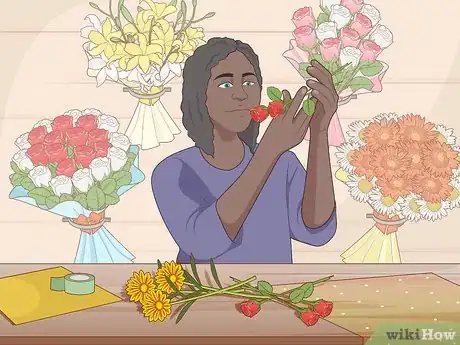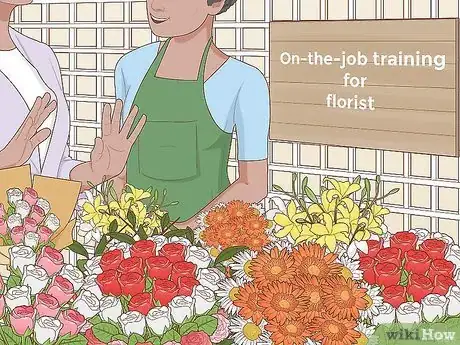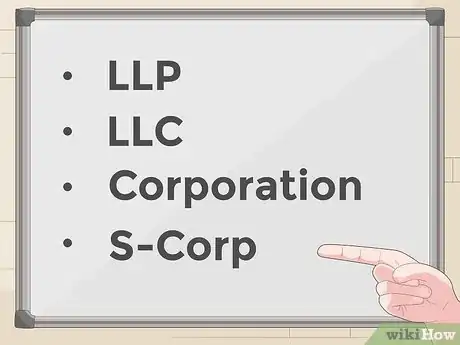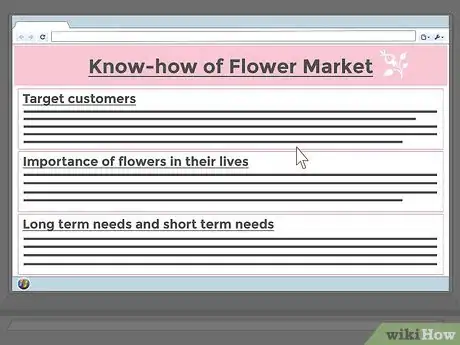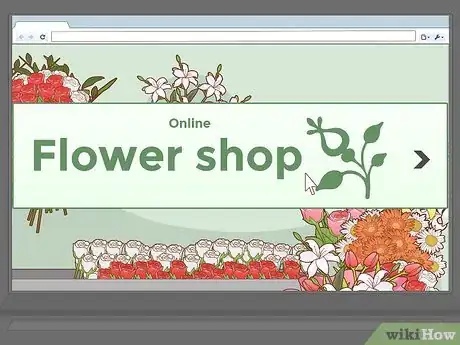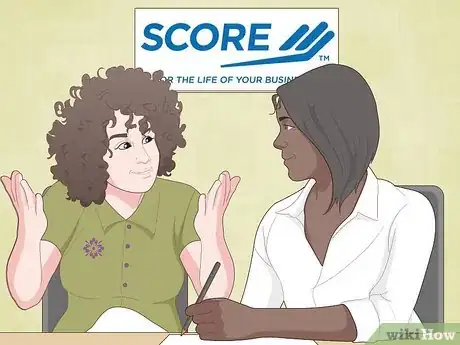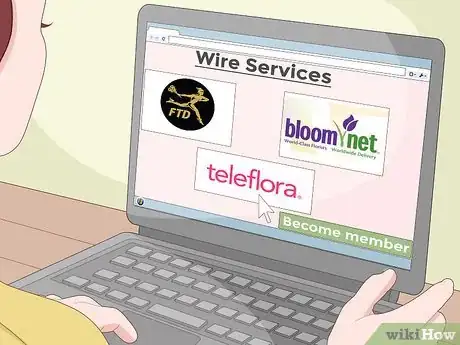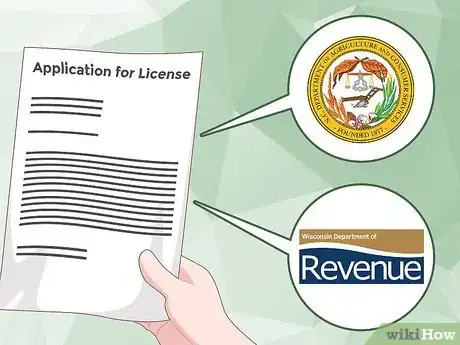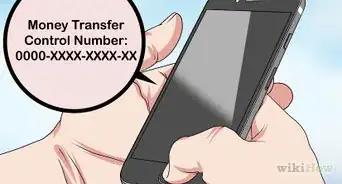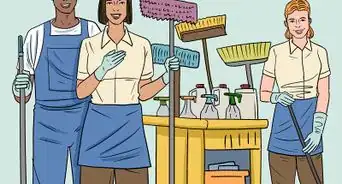This article was co-authored by Lana Starr, AIFD. Lana Starr is a Certified Floral Designer and the Owner of Dream Flowers, a floral design studio based in the San Francisco Bay Area. Dream Flowers specializes in events, weddings, celebrations, and corporate events. Lana has over 14 years of experience in the floral industry and her work has been featured in floral books and magazines such as International Floral Art, Fusion Flowers, Florist Review, and Nacre. Lana is a member of the American Institute of Floral Designers (AIFD) since 2016 and is a California Certified Floral Designer (CCF) since 2012.
There are 7 references cited in this article, which can be found at the bottom of the page.
wikiHow marks an article as reader-approved once it receives enough positive feedback. This article received 12 testimonials and 100% of readers who voted found it helpful, earning it our reader-approved status.
This article has been viewed 235,859 times.
If you're interested in starting a flower shop, the first step is to learn more about the floristry business. If you're skilled with floral design, have strong interpersonal skills, and a good business sense, opening a flower shop could be a good future for you. To open your shop, develop your business's plan, mission, and structure.
Steps
Learning About the Floristry Industry
-
1Have the natural skills a florist requires. Florists not only love working with flowers and plants, but should also possess a keen eye for detail, and creative flair. You'll have to be good with your hands, and physically fit.
- It will help to have good interpersonal skills. The retail portion of your business, means that you'll be dealing with customers as they come in to shop for flowers
- The flower arrangements for weddings and funerals are often made in times of high stress, where emotions are close to the surface. You'll have to be able to be helpful, diplomatic, and practical in difficult situations.
-
2Learn the trade of a florist. To learn the trade of a florist, you can either go through a community college program or learn by apprenticing with a florist. Some community colleges have certification programs in floral design, but there is no requirement for college credits in order to work as a florist.[1]
- Working for a florist while you attend college is a good way to get the most out of your training.
- If the florist doesn't have any jobs or internships arranging flowers, you could consider doing part-time work cleaning the shop or other unskilled tasks in order to get a sense of the way a shop works.
Advertisement -
3Consider on-the-job training. Working for a florist is the most efficient way to learn what skills you'll need, because you'll learn first-hand the pressures and rewards of owning your own shop. In addition, you'll likely learn cost-saving measures and floral design secrets that won't be found in community college programs.[2]
- Someone who works in floral design is usually more up-to-date on the latest trends in the flower industry as opposed to someone whose involvement has been more academic.
- If you plan to open your flower shop in the same city, county or state, you'll learn more about local resources and licensing requirements. While there are no formal requirements for becoming a florist, you'll need to apply for a business license and follow all local tax and building codes.
-
4Think about risks and benefits of opening a flower shop. Someone who runs his own flower shop will have to expect to work from quite early in the morning, as early as 4:30 a.m., until the end of a typical business day, 5:00-5:30. Your shop will likely be open at least 6 days per week.
- You'll have to be plan ahead for busy seasons (generally around Valentine's Day and Mother's Day) and slow seasons (January and August tend to be slow seasons for the floral industry).
- If you're thinking of hiring any employees, you'll need to make sure they're well trained. Customer service is essential in running a successful flower shop.
Developing a Business Plan
-
1Define your business's mission. Most people write a business plan in order to apply for a loan, but even if you don't intend to apply for a loan, a business plan can be helpful. The more clear you are about your business's mission, the more accurately you may be able to target your marketing, inventory, and design.[3]
- A sample business mission statement might read: "Mary's Farm Flowers will work with local farms to employ workers with disabilities to create floral arrangements for the Sailway Community. 10% of all proceeds will be returned to local charity organizations to support residential programs for disabled adults."
- Another example of a mission statement might read: "Shazam Flowers And More provides delivery service to your home, work, or corporate function in the Tri-City Metro region within one hour of request."
-
2Decide what sort of business structure will be best. Most new flower shops opt for a sole-proprietorship business structure, as this is the simplest structure. A sole-proprietorship business structure means that all decisions and responsibilities are those of a single person. Other options include:[4]
- Limited-Liability Partnership: A limited partnership is made up of one or more partners with unlimited liability for all debts incurred by the partnership, and one or more limited partners whose liability is limited to the extent of his or her capital contribution. The advantages of forming a partnership is that it is fairly easy to set up, and each partner bears a certain portion of both the risks and the profits. The disadvantage is that all partners must agree upon all business decisions, and sharing the liability and profits may result in disagreement at times.
- A Limited-Liability Corporation (LLC): A Limited Liability Company is an unincorporated business organization run by one or more business partners, called partners, each of whom has limited liability for the contractual obligations and other liabilities of the business. This business structure is more flexible than either the corporation or the nonprofit model. The advantages of an LLC is that it prevents any individual member/owner from bearing the financial risks of the company. The disadvantages are that, in many states, the LLC is dissolved when any individual member leaves.
- A Corporation: A corporation, sometimes called a c-corporation, is an business that is separate and distinct from the individual(s) who own and manage the business. This is a complex business structure that is best suited for a large, established business with multiple employees. Corporations have some tax advantages, and potential employees may look favorably on the corporate structure. However, for someone just opening a flower shop, the paperwork necessary for starting up a corporation are time-consuming and costly.
- An S-Corp: To register as an s-corp, you must first qualify as a corporation. Once you are established as a corporation, you may decide to transfer your structure to that of an s-corp. This business structure is not recommended for someone starting up a flower shop, although a large and established flower company may elect to use this structure.
-
3Do market research. Who will your likely customers be? What are their habits of flower-buying, and what are they most likely to purchase? Consider as much information as you possibly can regarding your customers (market).[5]
- Things to think about include knowing what role flowers are likely to play in the lives of your customers. Are they likely to purchase flowers for people who are sick or dying? Or are flowers an important part of community events/celebrations/birthdays?
- Think about what businesses are in your community and what role flower may have in their operation. For example, do industry leaders in your community regularly include floral arrangements in their lobbies or conferences? Is your area one in which "destination" weddings take place? Do company leaders present flowers to their employees?
- Find out how much different businesses budget for flowers in their companies, and know how much they're likely to spend for a typical floral arrangement.
-
4Know your competitors. Competition for your new flower shop includes all flower-selling retail establishments in the area, including both locally-owned flower shops, farm flower operations, as well as large retail shops, "big box" stores, home-and-garden centers, grocery stores, etc.
- Increasingly, flower sales are being offered by online establishments, both large and small. Include online floral sales in your research.[6]
- Consider the ways that your competitors are reaching their target markets, and think about ways you can either reach different consumers, or compete directly with the existing stores. You might think about the ways the current flower stores aren't meeting the needs of the local market base, and try to find a way to meet those needs.
-
5Decide if you will have a storefront. If your research determines that people in your area are likely to purchase flowers online, you may not need to invest in a storefront. The benefit to this is that you won't have to depend on paying for real estate in popular shopping areas, or hiring a full-time store manager. You'll be free to make deliveries, pick up inventory, etc.[7]
- The disadvantages are that you'll still have to pay for a location to store and arrange your flowers, even if you are selling online.
- It may be more difficult to attract customers through a purely online store presence.
- If you choose to rent a storefront, you'll do best to find a location with high visibility, good parking, and plenty of walk-in traffic. This means that your rent may be expensive.
-
6Make sure there is some way to control temperatures in your location. No matter where you store is, you'll need to be able to store your flower inventory at a fixed temperature. If your temperature is too high or lower, your flowers may wilt or shrivel. You won't be able to sell them.
- The optimal temperature to store most flowers is 34 to 36 °F (1.1 to 2.2 °C) (40 degrees maximum)
- Some flowers do best at 30 °F (−1.1 °C), and will not freeze at these temperatures.
- Flowers keep best in high humidity. Relative humidity should be no lower than 80% and is best kept between 90%-95% humidity.
- Tropical flowers should be stored at 55-60 degrees. Cooler temperatures may damage them.
-
7Take out a loan if you need to. Start up costs vary considerably, depending on factors such as renting a location, investing in refrigerators for your inventory, marketing fees, insurance, etc. You'll need vases, pruning equipment, ribbons and other supplies.[8]
- Experts recommend budgeting at least 2-3 times your purchase price for the first year you're in operation.
- Consider talking with the SBA-supported free organization SCORE, which is a volunteer organization comprised of retired business executives who can help you determine your business needs.[9]
-
8Decide if you'll be a member of a wire service. Most flower shop owners decide to pay a monthly membership fee in exchange for receiving orders through the flower service, such as FTD, Teleflora and BloomNet. These orders can come from anywhere in the country, and may even be ordered internationally. For example, a customer can walk into a flower shop in Brooklyn and order a flower arrangement to be delivered in Los Angeles through FTD. Both flower shop owners (the one who takes the initial order, and the one who delivers it) receive a portion of the sales.[10]
- While this may bring in additional sales, the percentage of each sale (as much as 27%) paid out to the wire service means less profit for the small shop owner.
- There may be an initial start-up fee as well, depending on the service you choose to work with.
-
9Apply for any necessary licenses. Most municipalities require that flower shops have a business license. You may also need to apply for a resale license (also called a reseller's certificate) because you'll be charging sales tax on the resale of your inventory. Check with your local state and city business offices.
- For example, in the state of North Carolina, a flower shop will need to have a license through the NC Department of Agriculture and Consumer Services.
- In Wisconsin, you must apply for a seller's permit through the Wisconsin Department of Revenue.
Community Q&A
-
QuestionI want to find someone's flower shop business license. Where can I do this?
 Community AnswerYou should consult your municipal government department advisory department in order to find someone's license.
Community AnswerYou should consult your municipal government department advisory department in order to find someone's license. -
QuestionHow do I get access to flower warehouses?
 Community AnswerDo a Google search for flower wholesalers in your area. Call them, email any necessary documents over, and follow any other required steps to open up the relationship.
Community AnswerDo a Google search for flower wholesalers in your area. Call them, email any necessary documents over, and follow any other required steps to open up the relationship. -
QuestionHow can I get wire service if I work at home?
 Community AnswerMake a webpage that connects to your database. If anyone places an order online, you get the notification on your computer.
Community AnswerMake a webpage that connects to your database. If anyone places an order online, you get the notification on your computer.
Warnings
- Inventory spoilage averages around 35%, which may be a larger cost than you can easily bear.⧼thumbs_response⧽
References
- ↑ Lana Starr, AIFD. Flower Shop Owner. Expert Interview. 24 March 2020.
- ↑ Lana Starr, AIFD. Flower Shop Owner. Expert Interview. 24 March 2020.
- ↑ http://nsbdc.org/wp-content/uploads/2010/11/E14MarketGardeningBPlan.pdf
- ↑ https://www.sba.gov/category/navigation-structure/starting-managing-business/starting-business/choose-your-business-stru
- ↑ http://openaflowershop.com/market-research.html
- ↑ http://openaflowershop.com/market-research.html
- ↑ http://openaflowershop.com
- ↑ http://www.nerdwallet.com/blog/small-business/start-floral-business/
- ↑ https://www.score.org/mission-vision-values
About This Article
If you want to start a flower shop, you will need an eye for detail, creativity, and determination. To hone those and other skills, you'll have to take apprenticeships or college courses before opening your shop. Once you've been trained, you may need a loan to buy a refrigerator to keep the flowers in a room between 34 and 36 °F and with 90-95% humidity. When applying for the loan, remember to factor in the price of land if you are planning on opening a storefront. For tips on determining a business model and applying for the appropriate licensing, keep reading!
